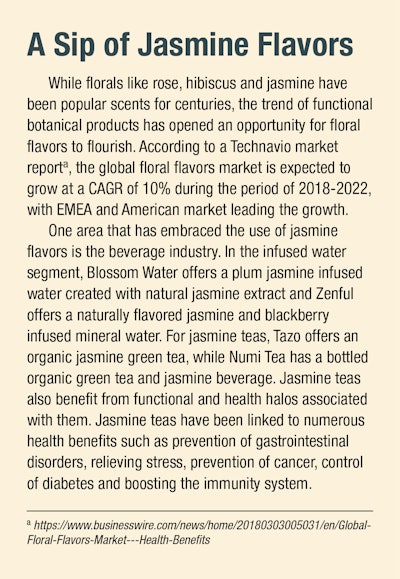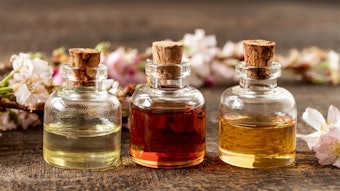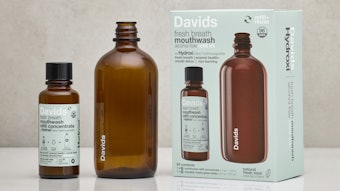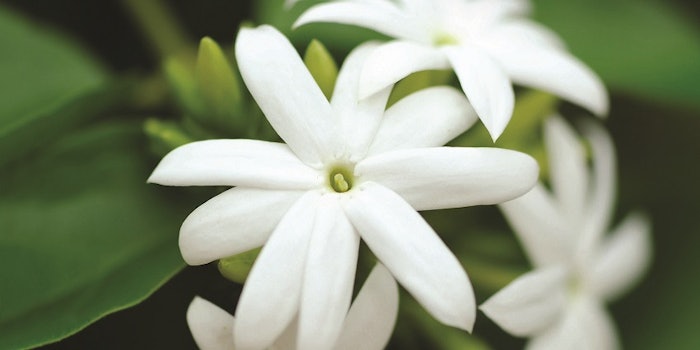
Jasmine absolute is widely used in perfumery and fragrances for cosmetics and toiletries to impart unique floral scents. In traditional holistic medicine and in aromatherapy jasmine is considered one of the most effective products to relieve stress, anxiety, nervous tension, depression and exhaustion. It can be used also as an antiseptic (also anti-viral) and as an anti-inflammatory agent.
Classic French fragrances owe much of their existence to jasmine (e.g. Mitsouko, Chanel N°5, Shalimar, Arpège, Joy, Femme, Miss Dior, L’Air du Temps, Cabochard, Madame Rochas, Calèche, Fidji, Chamade, First, Opium, Coco, Samsara).
Jasmine does not yield an oil by steam distillation, i.e. jasmine essential oil, as defined by ISO 3218 “Essential oils. Principles of nomenclature,” does not exist as a commercial product. The most common extraction method, representing more than 98% of jasmine production worldwide, involves a two-step method where hexane is first used to extract “jasmine concrete” (a solid, waxy-buttery product made of oil and wax) from the blossoms while recovering the hexane for further extraction cycles. The concrete is ultimately either commercialized as is (for further processing by the buyer) or converted by the jasmine concrete producer into “jasmine absolute,” a liquid oil free of waxes. This is performed by washing the concrete numerous times with ethanol (at negative temperatures) to allow the soluble fraction on the concrete to dissolve into the ethanol, while preventing the flaking wax from doing so and easily removing it by filtration. The ethanol-absolute solution is then distilled to separate one from the other.
A good quality extract can also be obtained by supercritical carbon dioxide extraction, but this is performed after a hexane extraction in lieu and place of the ethanol step of the previous process. Jasmine extract solutions in e.g. di-propylene glycol or isopropyl mirystate are incorrectly called “jasmine oil.” Also remarkable is the existence of jasmine extracts which are 100% certified organic, therefore not produced with the use of a petroleum/synthetic/mineral solvent (i.e. hexane or other), these extracts are mainly intended to be used in aromatherapy applications, but also offer different organoleptic facets of great interest in fine fragrance or flavor applications.
According to Kerala Agriculture University, more than 80 species of the Jasminum genus are found in India, however, there are four main species mainly used in perfumery and fragrances: Jasminum grandiflorum and Jasminum sambac and to a much lesser production extent, Jasminum asteroides and Jasminum auriculatum. Due to their importance and volumes, only the grandiflorum and sambac species are the subject of this report.
Jasminum grandiflorum
The two main producers of Jasminum grandiflorum concrete are India and Egypt. Together they account for about 95% of the market share. In India, the estimated production of concrete in 2014 was about 5.5 to 6 tons. While Egypt may have produced as many as 4.5 tons in 2014. In Egypt’s case, these figures have come down from 11 tons/year in the mid-1970s.1 Other contenders are Morocco and China. Trials have been attempted in South Africa without conclusive results.2
In India, although cultivated throughout peninsular India in varying degrees, the extracts are produced predominantly in the Coimbatore district of Tamil Nadu state where the flowers are grown under contract primarily for extraction purposes. Anecdotic quantities are produced for religious and wedding functions. Approximately 90% of grandiflorum flowers of the Coimbatore district are used for extraction purposes but only 10%-15% of the total grandiflorum cultivation in the state of Tamil Nadu is estimated to be used for extraction and almost none from those of other states. Government estimates of total grandiflorum acreage under cultivation in Tamil Nadu alone is about 7,000 acres. 3-4
In Egypt, 99% of jasmine plantations are located in the Nile delta, around the village of Shoubra Beloula El-Sakhaweya (commune of Kutur, province of Gharbeya). The remaining plantations occur in the Fayoum area. In recent years, jasmine plantations in Egypt have covered an area varying between 105-150 hectares and are supporting approximately 5,000 flower pickers. The network of dependent family members and businesses (family workers, transporters cooperatives, middlemen, etc.) probably accounts for some 30,000 people.5
Production and Processing Characteristics
In India, the season lasts from June to December and the flower harvest volumes are parabolic with a peak in August/September. In practice, the plant has a productive life from the 3rd to the 10th year and can yield about 5- 6 tons of flowers per hectare per year. The concrete yield from flowers ranges from 0.27% to 0.3%.
In Egypt, the period of production is typically from June to October but may be extended from end-May to early-December if production is considered short for the projected market demand. The plant has a productive life of over 25 years, but well-groomed farms generally replace a plantation every 12-15 years mostly because of drop-out bushes which impact the acreage productivity. A single hectare of land can produce between 9.5-14.2 tons of blossoms per year (4-6 tons per feddan/year, i.e. 4,200 m2) depending on extension of picking season and weather hygrometry and/or wetting of blossoms by farmers. Each ton of blossoms gives 2.6 kg of concrete (0.26% yield) as an average over a season. Dry blossoms (not wetted by dew or intentionally by the picker) yield as much as 3.1 kg/ton concrete. Egyptian concrete yields between 55% and 61% of jasmine absolute. The by-product of jasmine absolute – i.e. jasmine wax – has a market in the cosmetics, candles and wood furnishing polish treatment. The processing of the Jasminum grandiflorum takes place mainly at farm/district level.
Social and Economic Characteristics
In India, picking activity of the flowers is done manually. On average 3 to 4 kg of flowers for extraction are picked a day in 5 hours, while for flower market sale it could extend to 7 – 8 hours a day. Usually, all family members work in this activity. Jasmine (both grandiflorum and sambac) are important commercial crops in their areas of cultivation. Being hardy and drought-resistant crops, they are typically grown in the drier regions (irrigation is mostly limited to critical periods in the cultivation cycle). Due to the labor-intensive nature of the crop, the average size of a jasmine farm is less than half an acre. Hence, they are grown primarily by small and marginal farmers of these regions.
Correspondingly (both due to the hardy nature of the crops as well as the limited financial capabilities of the farmers), very few inputs of either fertilizers or pesticides are used in a scientific manner and any such application is limited to traditional practices. Jasmine is also preferred by these farmers as they provide income (even if variable) over an extended period of time. Also, the established demand and corresponding trade (that is relatively efficient and free-market) in these flowers reduce risks that are otherwise inherent to such a perishable product.
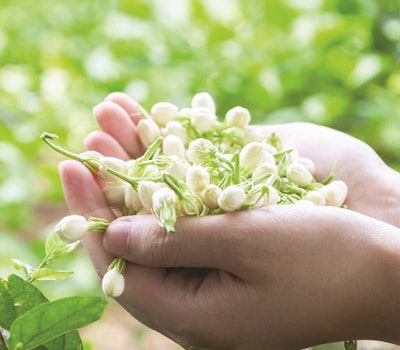
In Egypt, picking activity of the flowers is also done manually, every day of the season, between 3:00 and 10:00 a.m. On average 3 to 4 kg of flowers are picked, a day, in 5-6 hours. Some individuals are capable of collecting up to 12 kg in the same time. Usually, all family members work in this activity with an emphasis on women who obtain a consequential revenue from this activity which they can spend on their future dowry (if unwedded), children’s education, house spending. This revenue goes untaxed as per Egyptian law. The steady income over a seven-month period is much appreciated by farmers as it is unique when compared with traditional crops that procure revenue only upon a single (i.e. spot) harvest (e.g. wheat, rice, corn). Moreover, jasmine contracts involve in most cases different degrees of pre-financing for the farmers from the factories helping to strengthen a sustainable economic substrate. Jasmine provides the highest consistent return of all crops in Egypt. Cost of cultivation/ha/year is around US $6,500 (including harvesting costs). In winter, farmers intercrop lettuce, peas, or clover with jasmine plantations thus adding to their revenue. Jasmine is the second revenue entry of Egypt’s national aromatic raw materials turnover with some $6.5 million in value, where 100% of the production is exported providing a hard currency source to the country and a unique opportunity for farmers to obtain directly the dividends of their efforts without governmental interference (i.e. in the form of regulated market, imposed market pathways, taxes, etc.).
Jasminum sambac
Despite being relatively new to the international market, the demand for this product has grown rapidly to reach a stable and reasonable market size. Sambac concretes and absolutes used to be produced and consumed in India before it became increasingly popular in the global F&F industry. The estimated production in 2014 was about 3 to 3.5 tons of concrete. The current annual demand of Jasminum sambac concrete is believed to be around three tons. While India is the primary origin, China is, to a much less extent, another source for this product.
Jasminum sambac is cultivated throughout peninsular India and to a smaller extent in the Gangetic plains. However, most of the cultivation and all the extraction is undertaken in the state of Tamil Nadu. Government estimates of total sambac acreage under cultivation in Tamil Nadu alone is almost 16,000 acres.3, 4 It should be noted that in the districts of Madurai; Virudhunagar, Theni; Dindigul and Sivaganga have been granted a Geographical Indication Mark for the Jasminum sambac flowers grown there. Egypt, though not a producer today of jasminum sambac, used to be an important producer in the 1970s. As the botanical is still present in the country, Egypt could well reactivate its production at any time.6-7
Production and Processing Characteristics
In India, the season lasts from March to October, or longer in case of a mild winter, while the flowering is in flushes. In practice, the plant has a productive life from the 3rd to the 8th year and can yield about 4 - 5 tons of flowers per hectare per year. The concrete yield from flowers is between 0.12% to 0.13%. About 5% of Tamil Nadu’s total flower harvest used to be the share of the perfumery industry when the demand was mostly domestic, but with increasing global demand this share is now closer to 10%. The same as with Jasmine grandiflorum, the processing of Jasminum sambac takes place mainly at farm/district level.

Social and Economic Characteristics
Defining an area of around 16,000 acres, production involves around 20,000 farmers, where each farmer has in average around 0.5 – 1 acre. Usually the whole family works in the farm with an average of four to five people in the family. There are around 80,000 to 100,000 people involved in the picking activity. Harvest times could extend to more than eight hours a day, and harvesting ability can vary from 0.25 – 1.25 kg per hour depending on flowering density and individual experience. One hectare produces around six metric tons of flowers per year. Cost of cultivation average could be around US$ 4,000 per year per hectare (including harvesting costs, which are the biggest ones).
Jasmine (both grandiflorum and sambac) are important commercial crops in their areas of cultivation. Being hardy and drought-resistant crops, they are typically grown in the drier regions (irrigation is mostly limited to critical periods in the cultivation cycle). Over 20,000 farmers in India cultivate jasmine as it provides income (even if variable) over an extended period of time. Usually, the whole family works in the farm with an average of four to five people in the family so there are around 80,000 to 100,000 people involved in the picking activity.
Jasmine plantations in Egypt cover an area varying between 105-150 hectares and are supporting approximately 5,000 flower pickers. Some other 30,000 people; family workers, transporters cooperatives, middlemen, are also participating in the jasmine business. Usually, all family members work in this activity with an emphasis on women who obtain a consequential revenue from this activity which they can spend on their future dowry (if unwedded), children’s education, house spending. This revenue goes untaxed as per Egyptian law. Jasmine provides the highest consistent return of all crops in Egypt and is the second revenue entry of Egypt’s national aromatic raw materials turnover with some $6.5 million in value. Approximately 100% of the production is exported providing a hard currency source to the country.

